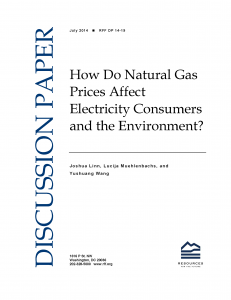 Coinciding with the recent increase in US natural gas production, the country has seen a 60 percent decrease in the price of natural gas. Lower natural gas prices have affected electricity prices and emissions rates differently across various regions. For example, during this time period, the Texas Reliability Entity experienced one of the largest decreases in the price of electricity but also one of the smallest decreases in the rate of emissions; whereas the ReliabilityFirst Corporation experienced one of the smallest decreases in the electricity price but one of the largest decreases in the emissions rate. Together with my coauthors, in a new RFF discussion paper, we theoretically and empirically explore the interrelated effects of lower natural gas prices on power plant operators, electricity consumers, and the environment, finding that lower electricity prices typically translate to less environmental benefits.
Coinciding with the recent increase in US natural gas production, the country has seen a 60 percent decrease in the price of natural gas. Lower natural gas prices have affected electricity prices and emissions rates differently across various regions. For example, during this time period, the Texas Reliability Entity experienced one of the largest decreases in the price of electricity but also one of the smallest decreases in the rate of emissions; whereas the ReliabilityFirst Corporation experienced one of the smallest decreases in the electricity price but one of the largest decreases in the emissions rate. Together with my coauthors, in a new RFF discussion paper, we theoretically and empirically explore the interrelated effects of lower natural gas prices on power plant operators, electricity consumers, and the environment, finding that lower electricity prices typically translate to less environmental benefits.
Here are the key points, in short. Low natural gas prices can result in a significant amount of fuel switching away from coal-fired generation at power plants. With more fuel switching, one would expect two things to happen: (1) electricity prices would decrease because an input price decreases and (2) emissions rates would decrease because natural gas is a cleaner burning fuel than coal. However, the degree to which these two outcomes occur will not follow in lockstep. This is because the amount of fuel switching that occurs also depends on the price of coal-fired generation.
Our empirical test of this theory incorporated detailed data on electricity prices, fuel consumption, and fuel prices from 2001 to 2012 to estimate the effects of natural gas prices on fuel use and generation from coal- and gas-fired power plants, emissions rates, as well as equilibrium electricity prices.
In cases where we see a lot of switching, it is because natural gas–fired generation is cheaper than coal-fired generation. Because the electricity price is set at the marginal cost of the highest-cost generator, when there is more switching, we see a smaller drop in the electricity price (because prices are set at the now-higher cost of coal-fired generation, not the falling cost of natural gas). But at the same time, with more switching, we see a larger drop in emissions. So, ultimately, the more that electricity consumers benefit from a price drop, the less we see environmental benefits.





